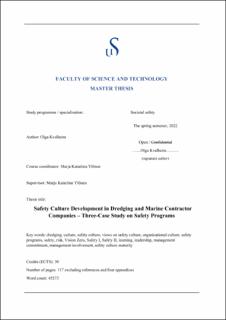| dc.description.abstract | After Chernobyl accident in 1986 it was concluded that a bad safety culture contributed to it. Development of a good safety culture became a regulation requirement in many countries, and a necessity in many industries including dredging and marine operations.
The thesis is carried out as a multiple case study applying qualitative methods. Three cases are represented by the leading dredging and marine contractor companies, being three out of four biggest in the world. Data was collected by means of nine semi-structured interviews and from documents related to safety culture and safety programs. The aim of the thesis is to better understand companies’ view on safety culture and its development; the influence of safety programs on safety culture and its measurement; related problems and challenges.
The theoretical framework grounds in intertwined concepts of safety culture and safety, model of organizational culture of Schein, and means to measure quality and maturity of safety culture.
Safety culture is being developed in the companies during the last 7-12 years within the framework of safety programs, which revealed great similarity. The results of the thesis demonstrate that the companies consider that safety culture can be engineered, changed, measured, and maintained. Safety culture is a part of companies’ organizational culture and helps to take care of safety, provides market advantages to the companies. Safety culture improvement leads to organizational culture improvement, namely communication, increase of trust, democratic management style, and highlights the aspect of care for all employees.
Safety culture is being developed within three core elements: mindset and understanding, structures and functions, and practices. According to the model of Schein (2017) safety culture is created within three cultural levels: artifacts (observable behaviour, structures, and processes), espoused beliefs and values (ideals, goals, rationalizations), and basic underlaying assumptions (taken for granted beliefs, values, which determine thought, perception, and behaviour). The mindset of the companies is based on the espoused values of Vision Zero and that proper safety behaviour improves safety; the underlaying assumptions that all incidents and accidents are preventable, and that safety behaviour will provide long-lasting safe performance. Management sincere commitment and involvement, employees’ empowerment, incentive structures, and reporting play important roles in a strong culture development. The study results show much focus on engineering risk assessment approach and less on sociotechnical perspective. The development is driven by industrial experience, market developments, and influence of ISO standards for risk.
The influence of safety programs on safety culture is measured by safety statistics, interviews, group dialogs, feedback, behaviour during trainings, and safety climate surveys. The quality of safety communication, employees’ care for safety, involvement, and management commitment are assessed. Safety culture maturity is evaluated and certified by external Safety Culture Ladder audits mostly upon tender necessity. Some companies’ units possess certificates of third (calculating) and fourth (proactive) maturity steps.
Development of safety culture is a gradual, continuous, and complex process demanding constant effort, monitoring, and financing. The cases demonstrate a reasonable progress. Safety culture evolutionized from compliance to rules and procedures to more proactive behaviour of all employees, nevertheless espoused values need to be extended by the ones reflecting dynamic and complex sociotechnical nature of safety. Combination of several safety perspectives, including sociotechnical perspective, Safety II and resilience can further improve existing safety cultures. Risk science can contribute to better understanding, assessment, and prevention of risks.
Certain problems and challenges were detected. Disrupted investments into the safety programs, insincere management commitment led occasionally to formal attitudes of employees. Companies’ growth, temporary employment, subcontractors’ involvement, and external influences create challenges for the safety programs and safety culture development. Learning, communication, and cooperation suffered during Covid-19 pandemic. Personal physical participation in learning was substituted by online participation and e-learning and undermined its quality. | |
